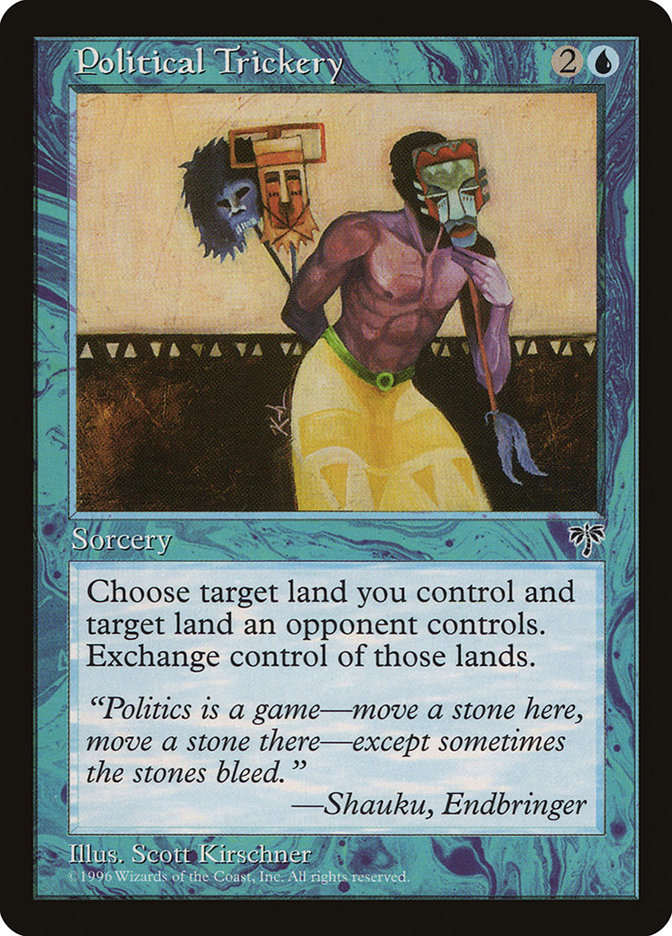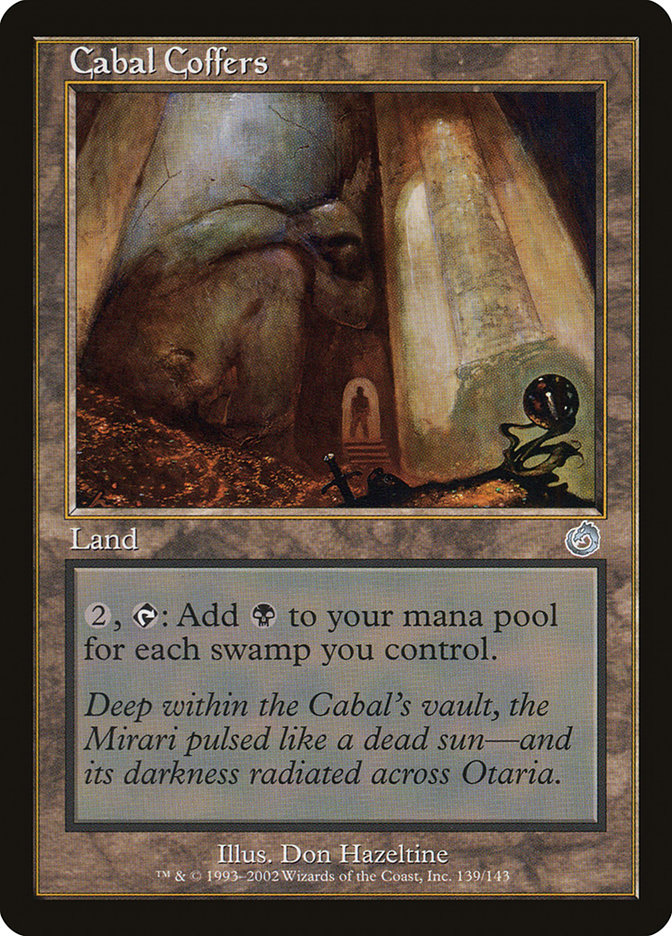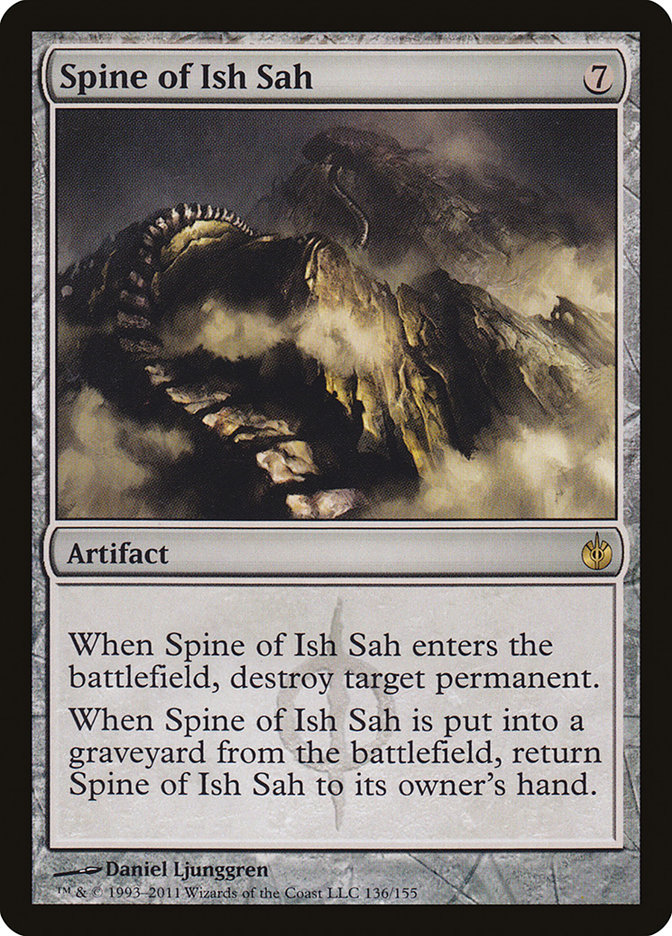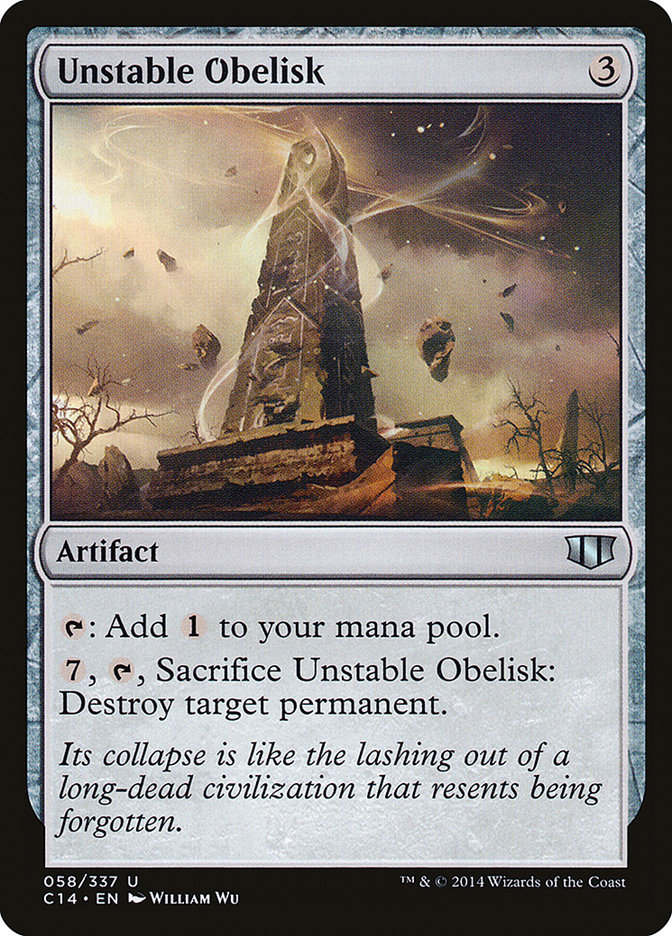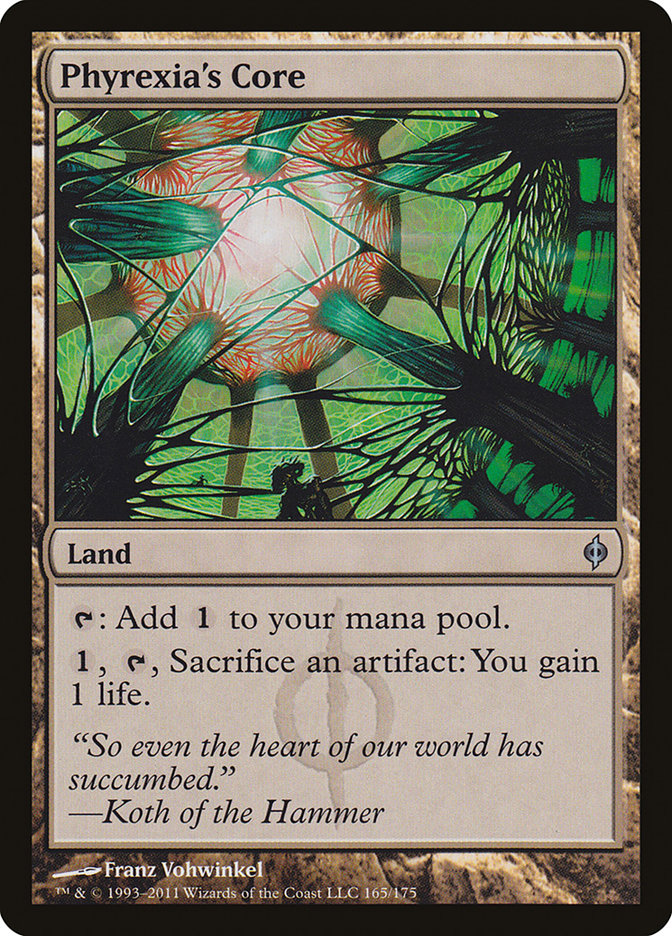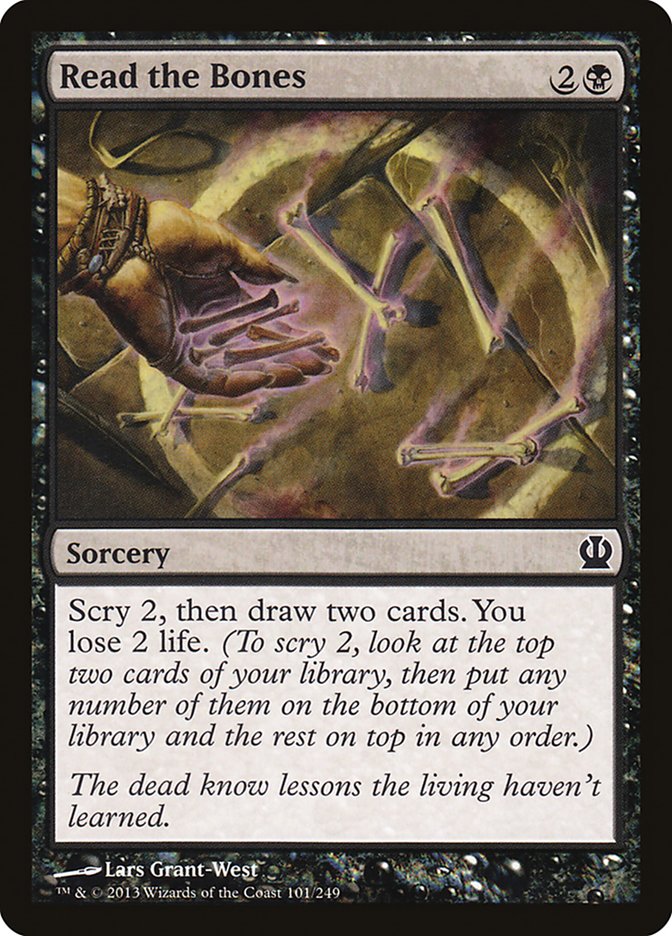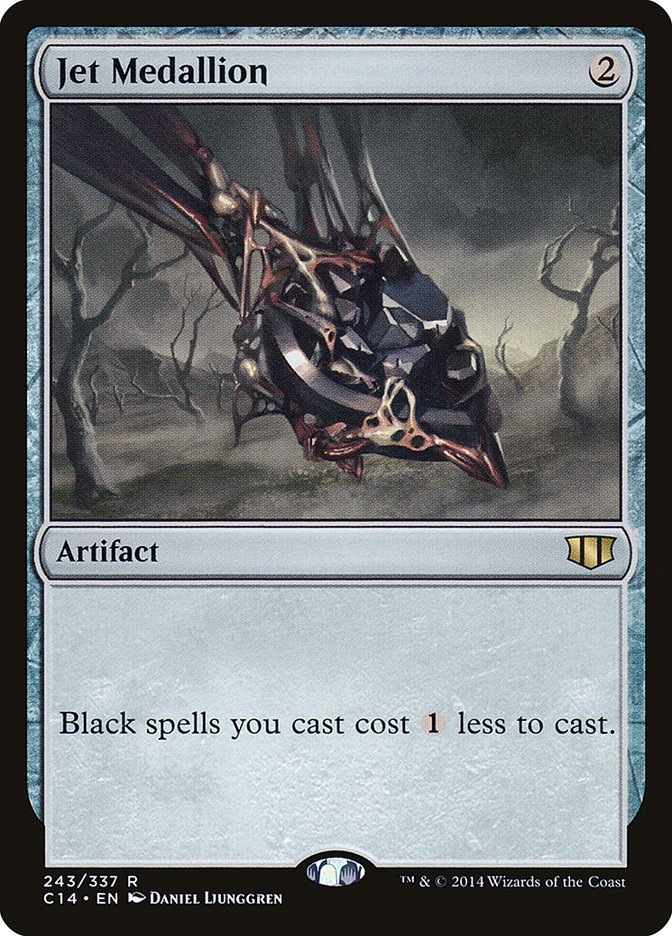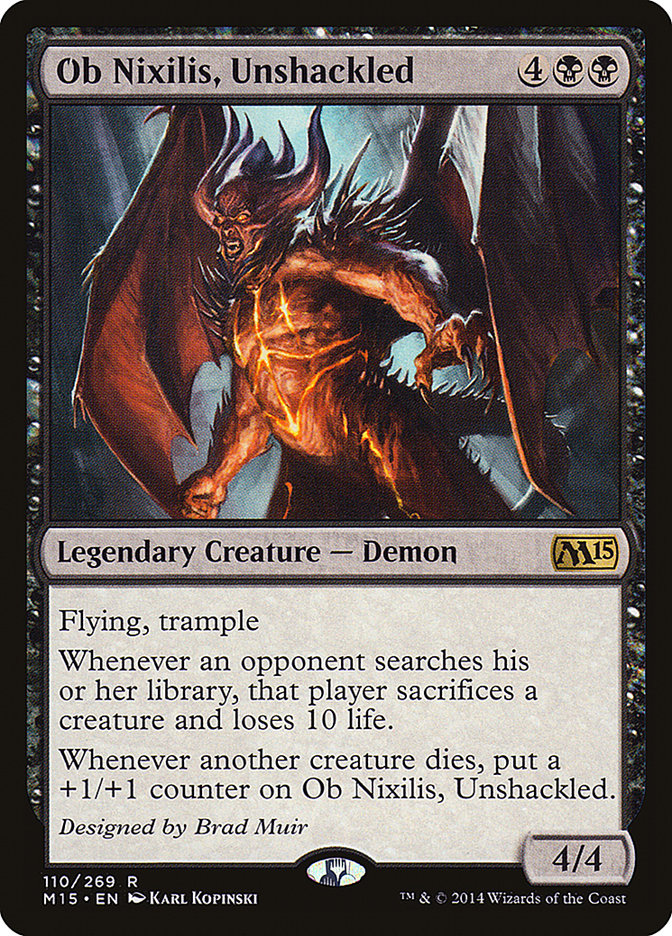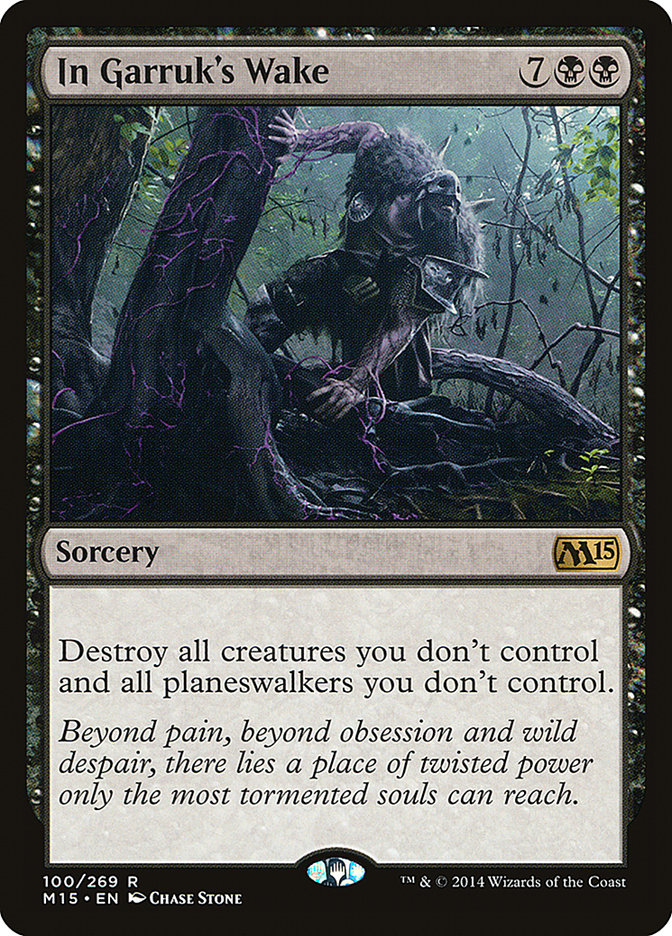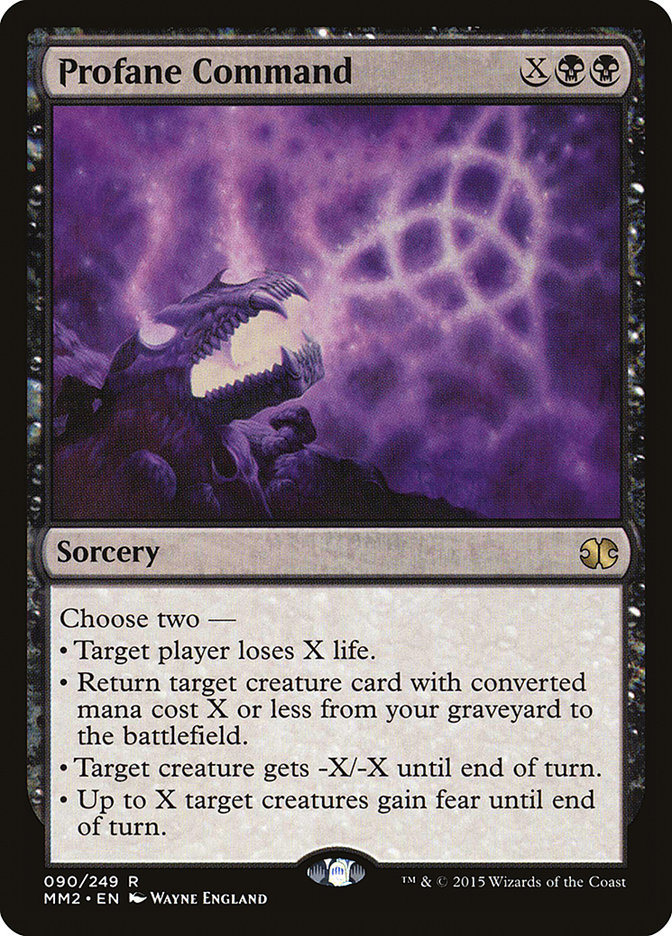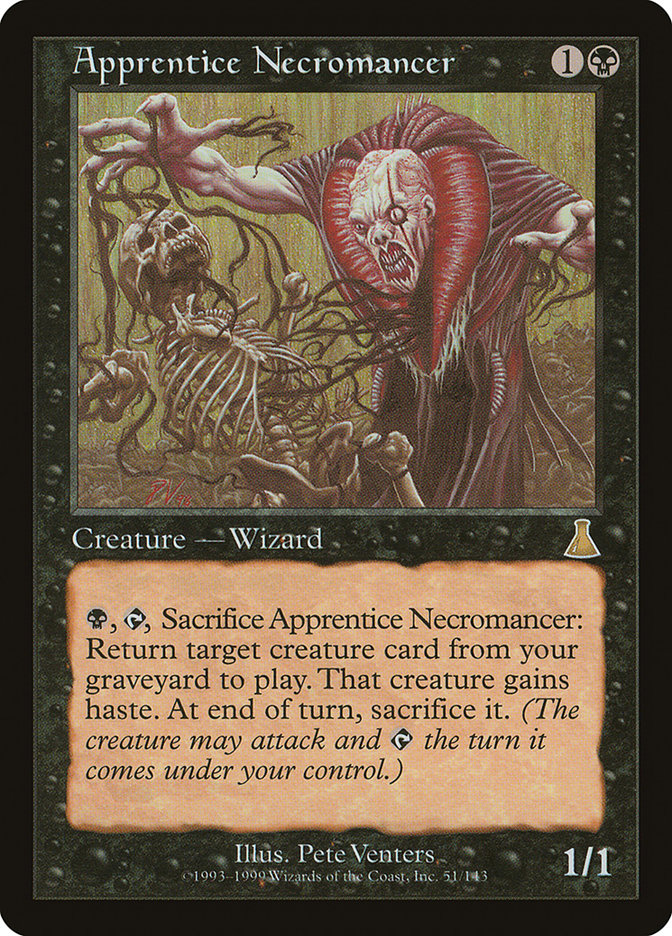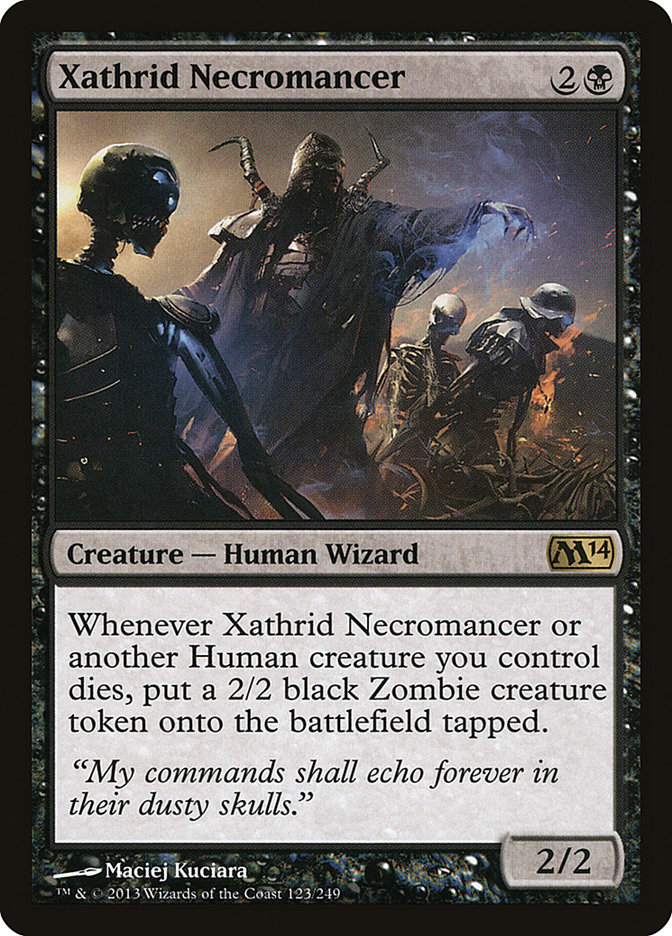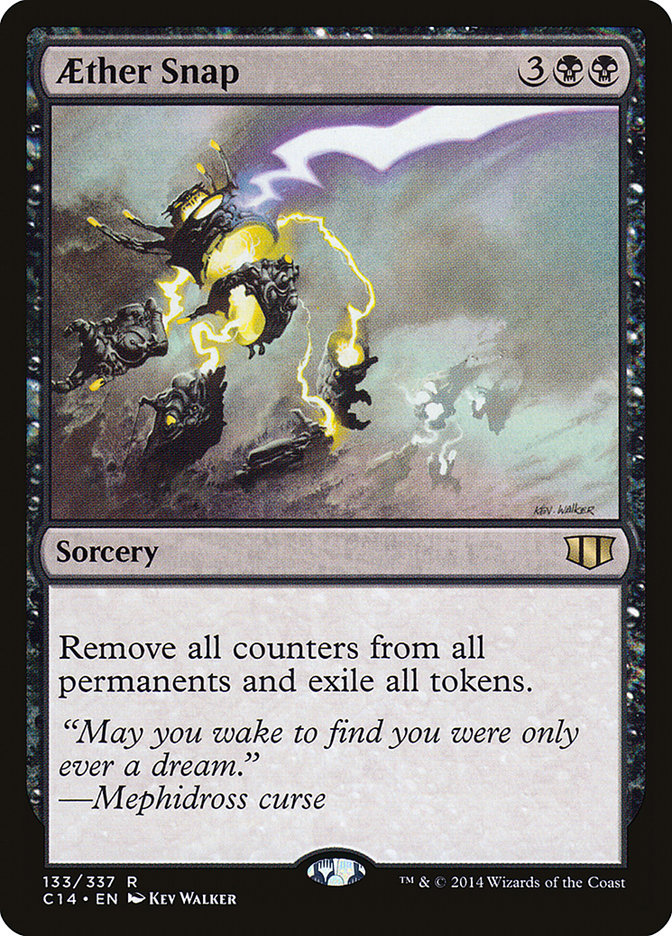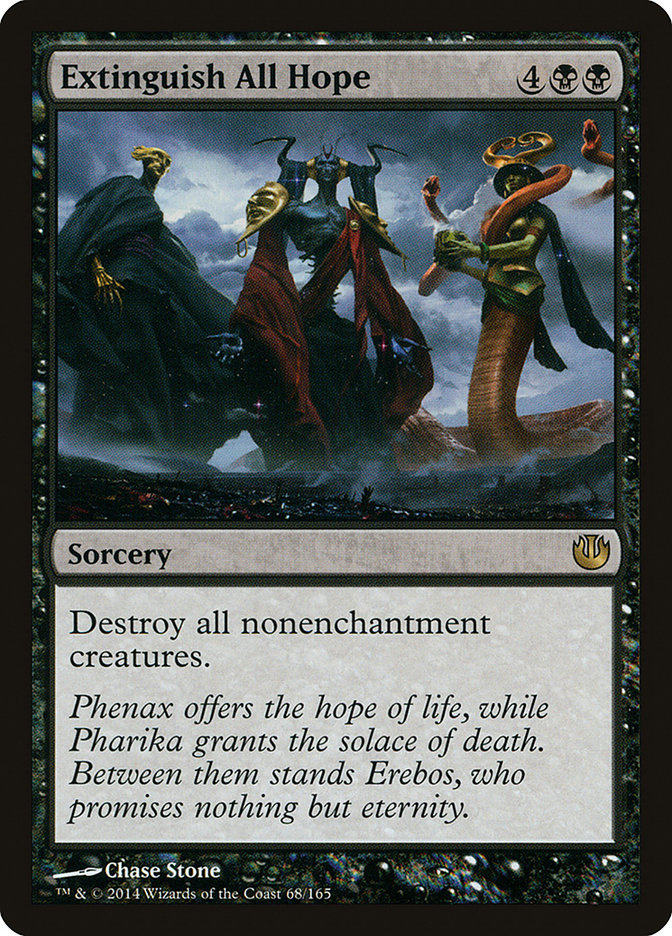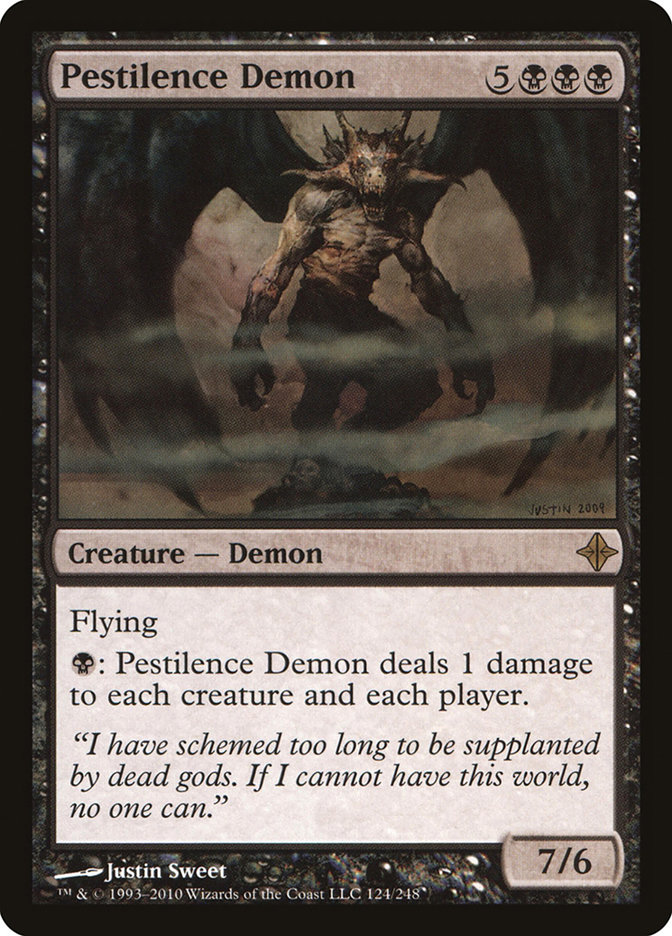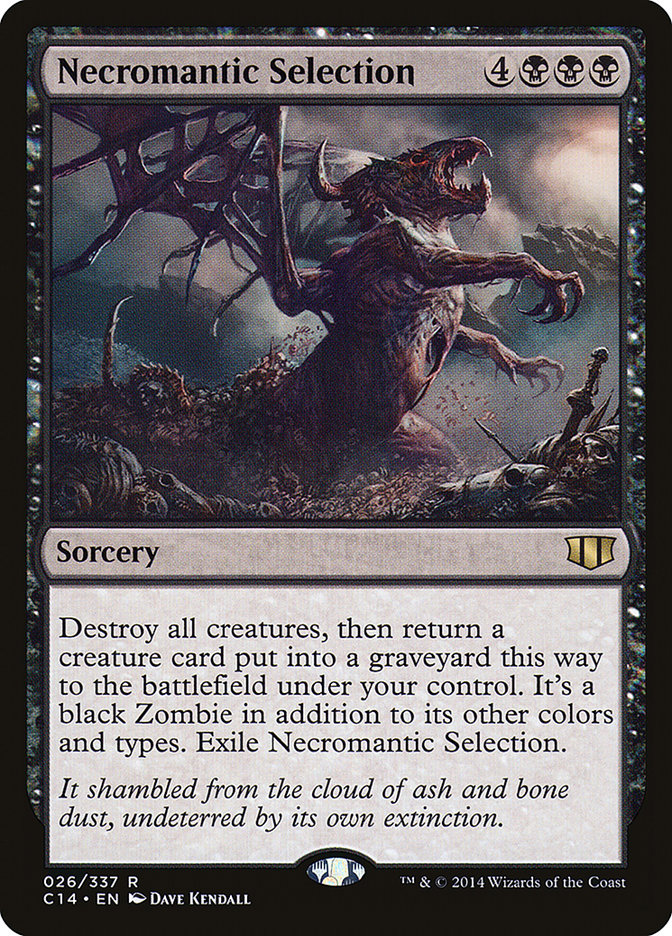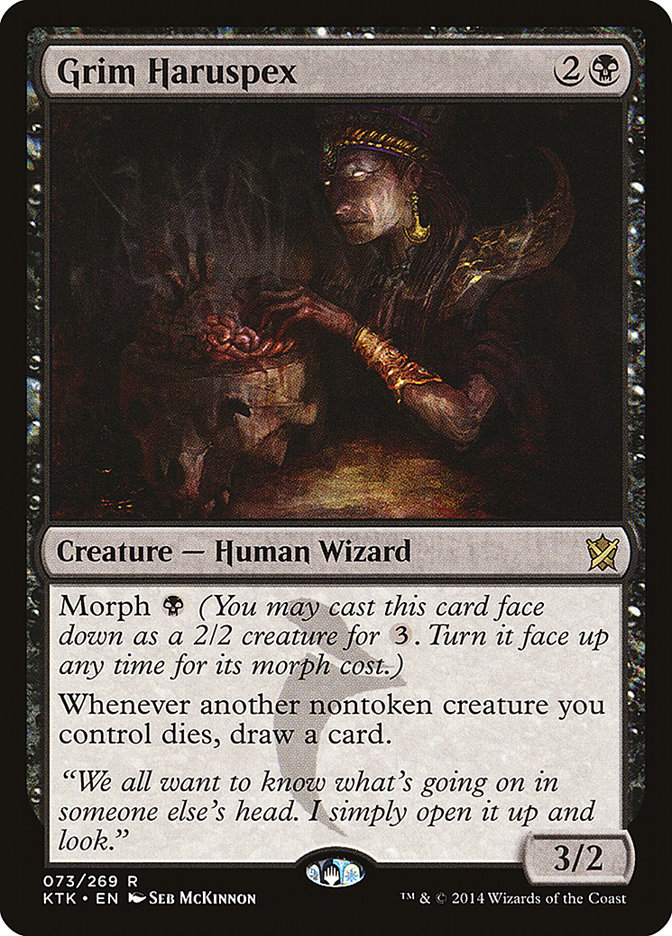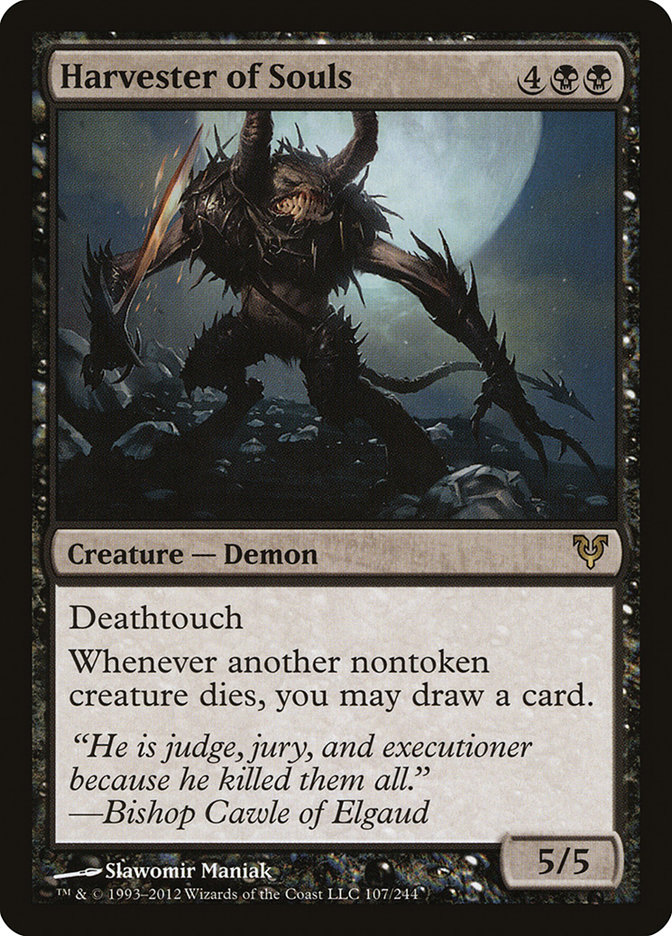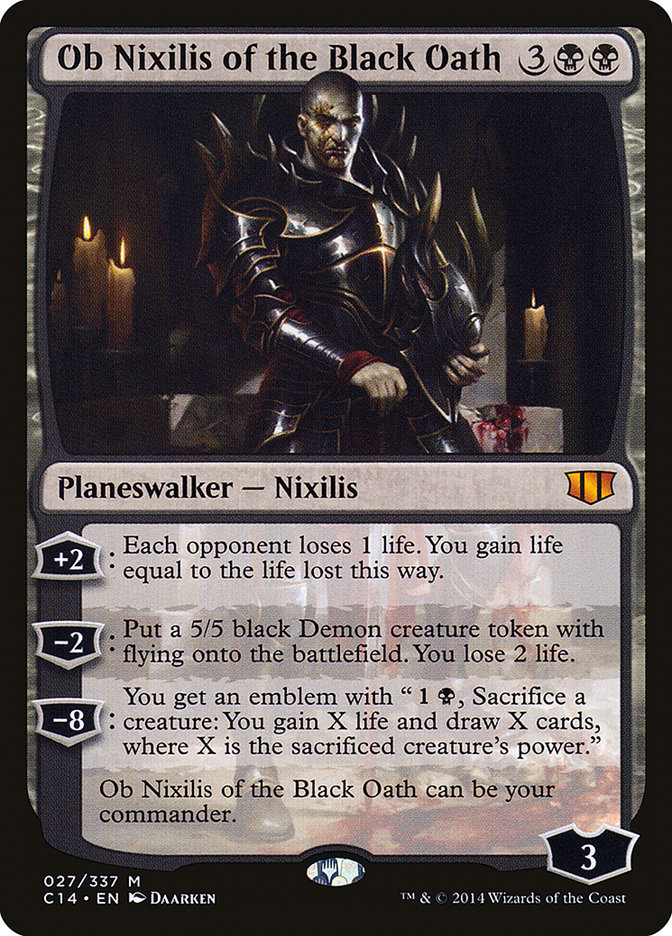If I have to pick a monocolored deck in the dark, I generally choose black. Of all the monocolor options in Commander, black is the most versatile. It has some true affinities, specifically around the sacrifice of life or creatures, but it can draw, kill, and field enough power (in a variety of forms) to win the game.
This week’s letter comes from someone who got back into Magic after a long time away. He’s fallen for Commander, this great format, so I am going to go over my basic theory of how to play a good social game.
It can be more difficult than it looks!
Dear Azami,
My daughter showed up with a handful of Magic cards two years ago wanting to know how to play. I had played Magic in the mid 90’s but had been away from the game for a long time. She re-sparked my fire and within a couple months I was at the local gaming store playing in an FNM. About a year ago I was introduced to Commander and I love the format. I started getting into the format by buying the pre-made Commander decks and tweaking them as I go along. The first deck was the mono-black deck, Ob Nixilis of the Black Oath. I have switched the commander to Kalitas, Traitor of Ghet and the deck is decent but I feel like it is still missing something or it is not defined enough. I have decent card draw, board wipes, beatdown creatures, and spot removal but while the deck does everything good it is not great at any one thing. My gaming group is about having fun and everyone wants to win but not by having “broken” combo decks. I would appreciate any and all help fine tuning my Kalitas deck into a scary, beautifully horrifying masterpiece that will have my fellow competitors afraid to go to sleep at night!
Thanks,
Ben In Iowa
Commander: Kalitas, Traitor of Ghet
Deck:
Sol Ring
Sign in Blood
Mind Stone
Skirsdag High Priest
Jet Medallion
Vampire Hexmage
Nantuko Shade
Demonic Tutor
Worn Powerstone
Commander’s Sphere
Cemetery Reaper
Mogis’s Marauder
Sudden Spoiling
Victimize
Xathrid Necromancer
Read the Bones
Underworld Connections
Flesh Carver
Grim Haruspex
Burnished Hart
Geralf’s Messenger
Squelching Leeches
Syphon Mind
Nekrataal
Null Caller
Erebos, God of the Dead
Desecration Demon
Tendrils of Corruption
Crypt Ghast
Whip of Erebos
Gray Merchant of Asphodel
Ghoulcaller Gisa
Dictate of Erebos
Indulgent Tormentor
Magus of the Coffers
Bloodgift Demon
Liliana Vess
Shriekmaw
Aether Snap
Archfiend of Depravity
Ob Nixilis of the Black Oath
Champion of Stray Souls
Soul of Innistrad
Reaper from the Abyss
Extinguish All Hope
Grave Titan
Ob Nixilis, Unshackled
Abhorrent Overlord
Necromantic Selection
Overseer of the Damned
Pestilence Demon
In Garruk’s Wake
Profane Command
Dread Summons
Liliana’s Reaver
Diabolic Tutor
Butcher of Malakir
Black Sun’s Zenith
Demon of Wailing Agonies
Sidisi, Undead Vizier
Gatekeeper of Malakir
32 Swamp
Crypt of Agadeem
Everglades
Polluted Mire
Arcane Lighthouse
Bojuka Bog
Myriad Landscape
First, I love how this story highlights the part of Magic I so love: Magic brings people together. This is most true for the multiplayer formats, whether they be Commander, Conspiracy, or just Group Game Draft – while one-on-one competitive formats like Standard and Modern offer plenty of ways to engage, you can’t get the party vibe you get over a table of four or more players.
My theory of Commander is that the format isn’t about winning, not exactly. Decks that are built to win do splashy things that draw aggro and force people to deny you the benefit of the doubt. I’ll never forget one time that I was playing Commander, I begged off being killed by someone and then comboed off the next turn because I drew the red source I needed. It felt unpleasant, and no one left that game happy.
No, the best way to build for Commander is to build for survival and resiliency. You’re not trying to win the game, you’re trying not to lose it. If you can keep your threat level somewhat unassuming, your opponents will fight amongst themselves. So long as you can moderate your threat level and keep anyone else from comboing off, you can enter the endgame with a resource advantage that typically translates into victory.
It’s one of the reasons I’m against combo: I like the three stages of a Commander game. There’s the early game, when you establish your resources; I advocate running 38 lands because it means you’re less likely to stumble in this table-setting stage. Then comes the midgame, where people do all the crazy things that make this format so wonderful; I advocate running plenty of draw engines so that you can keep your momentum through this stage. And then there’s the endgame, where the game draws to a close and you grind out the eventual victory between your battered army and a similarly-battered opposing army.
I set myself up to do well in the endgame while combo decks tend to try and skip it. Where’s the fun in that?
As for political strategy, I like to hold myself to some basic rules. I never lie, I try to avoid promising to do or refrain from doing actions in the future, and I am generally open about when the right play is to attack me or prune my board state. If I’m the only one who’s got their shields down, I’m not going to begrudge a necessary attack of opportunity. Of course, if you’re spending resources to mess with my position or to do suboptimal plays to my detriment, then I am going to get angry. And in those cases, I find a single proportionate act of punishment usually does the trick. You don’t want to spur on a blood feud and you may need that person on your side later in that very same game, but you have to make sure that they remember that retaliation when it comes time for them to again decide who gets shanked.
This is one of the reasons I am irked by people who let a die roll determine their attacks. Deciding who to attack is an area ripe for politicking, and if someone is throwing that away and injecting a random factor into the game, they become dangerous and unpredictable. And dangerous, unpredictable players can really mess up your plan for the game.
But if you’re always pointing to someone else as the big bad when you’re clearly the most dangerous one at the table, people are going to stop listening to you. That is death: like the Doctor, your words are your weapons. A deck should primarily give you the means to provide you with plays and interactions that offer the promise of political sway, and the less aggro you can pull while doing so the better.
Anyway, I took this Kalitas, Traitor of Geth deck and decided to apply some of this theory to the build. I decided what the deck was missing was a good synergistic subtheme, so I leaned into the Zombie theme suggested by Kalitas’s odd set of abilities. I’m pretty happy with the outcome, and hopefully Ben will be too.
Lands
Out:



In:
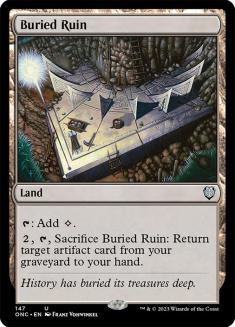
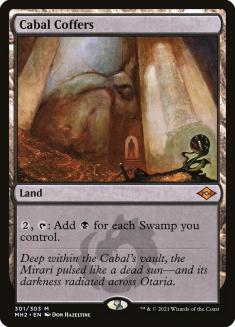
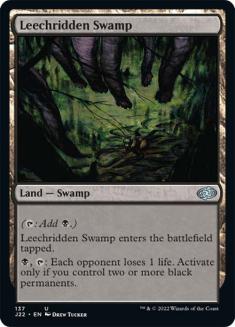
Let’s start with the money card I included in this build: Cabal Coffers. Normally I would suggest pairing it with Urborg, Tomb of Yawgmoth, but thanks to the success of Eldrazi in Modern the card is currently on a high spike. Consider picking it up when the inevitable bans take place, though I will admit I hold a certain theoretical fondness for the way those eldritch beings have shaken up two whole formats.
But in the meantime, Cabal Coffers is the type of card worth picking up if you like monoblack Commander decks. It will always be at home in a deck running mostly Swamps. If you like the format, it’s the type of staple that’s worth splurging a little bit on. I’m not suggesting Volrath’s Stronghold or Phyrexian Tower, both of which are also fun to play with, but this one is more universally playable than those two and it’s become a core part of monoblack’s color identity. It will be assumed that you have Cabal Coffers so you may as well have it, you know?
Buried Ruin
Out:
In:
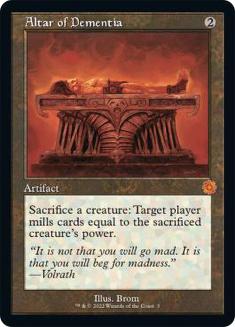
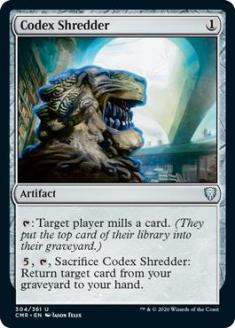
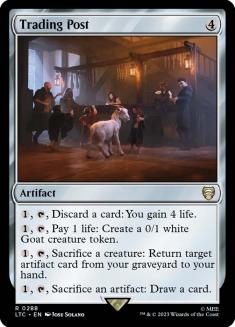
Altar of Dementia requires a bit more explanation. I brought it in because the sacrificial nature of the deck, one of the Kalitas, Traitor of Ghet abilities that seemed worth reinforcing, made me think this deck was a good candidate for it. One of the neat things Altar of Dementia offers is a victory condition that can be pointed at your own library to fill your graveyard with cards.
But black can’t directly recur all types of cards. Codex Shredder helps, while also providing another pseudo-draw mill ability, and Trading Post helps you get it back after you use it. Of course, if you happen to bin Trading Post, Buried Ruin gives you a way to get it back. Sometimes this won’t work out, and you’ll end with too many pieces in your graveyard to pull it off, but every once in a while the stars will align and it will be beautiful.
Incidentally, if you like these types of shenanigans, you can consider adding in Spine of Ish Sah, Unstable Obelisk, and Phyrexia’s Core. That was a little deeper than I wanted to go, but they expand the synergy to include removal options which can be particularly helpful if you find yourself against artifact- or enchantment-heavy metagames.
Draw
Out:
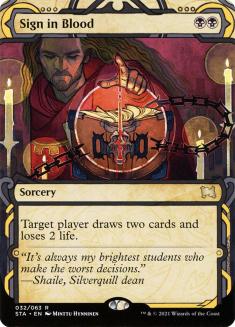
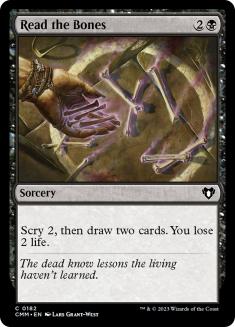

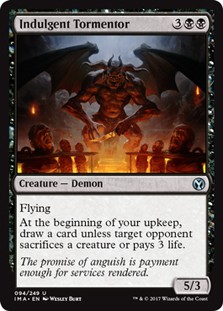
In:
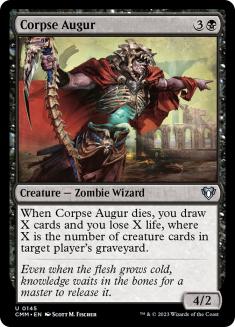
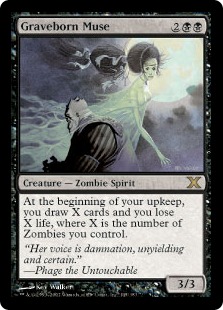
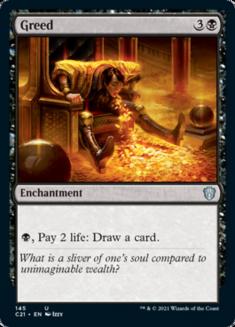
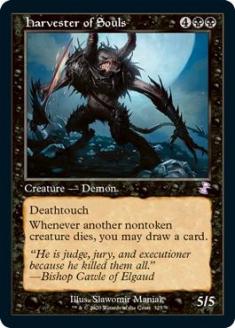
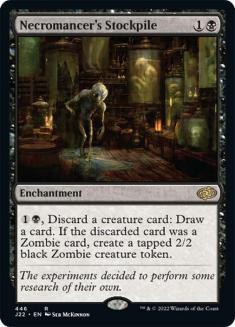
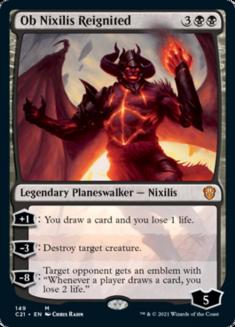
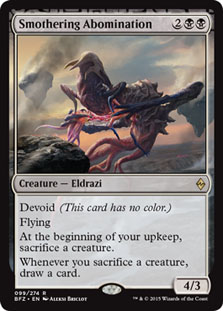
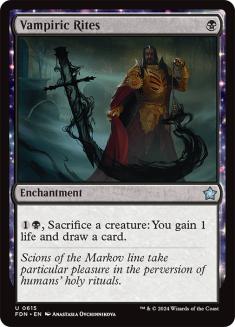
I love me a draw engine. Draw engines, as I see it, are (usually) permanents that promise to draw cards at multiple instances over the course of a game. The problem with draw spells is that they are vulnerable to hand disruption and hand-size limitations. That’s fine when it’s attached to a body, like Mulldrifter, because then you can reanimate or bounce or otherwise get multiple bites at that apple, but in decks unable to recur spells they’re often strictly worse.
Don’t get me wrong, in the right deck Sign in Blood and Read the Bones are decent spells, but this isn’t that deck. Kalitas, Traitor of Ghet has certain inclinations, and Sign and Read don’t play to those synergies. Indulgent Tormentor vaguely does this, but it offers too many ways to keep you from gaining value at little cost for decks with token swarms or a huge life advantage.
Syphon Mind, meanwhile, is a bad card. It has its supporters, and has been in a bunch of different products, but I think it’s overvalued. Basically, Commander games don’t tend to have more than five players total, six in stretch cases. In most situations, this is going to be a draw three spell for four mana. Then subtract one for anyone who is hellbent when you cast it, or who has been killed by that point (which means it’s worse in the endgame). If that wasn’t enough, you’ve irritated your average opponent, and delighted the one for whom stocking the graveyard is actively part of their plan. I don’t really play it much anymore myself.
I brought in a bunch of draw engines. Some are Zombie-themed, like Corpse Augur, Graveborn Muse (great even with no other Zombies in a deck), and Necromancer’s Stockpile; some are sacrifice-based, like Harvester of Souls, Smothering Abomination, and Vampiric Rites. Greed is good in this deck because Kalitas, Traitor of Ghet gets big and gains you life, meaning you’ll generally have the life to pay its steeper rate. Finally, Ob Nixilis Reignited keeps some Ob in the deck (I cut the other two versions) while providing both draw and removal. That versatility will serve you well, and Ob Nixilis Reignited is generally going to be valuable in a broad range of Commander decks.
Ramp
Out:
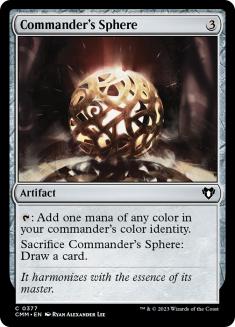
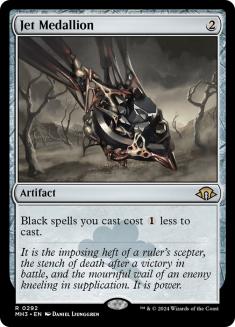
In:
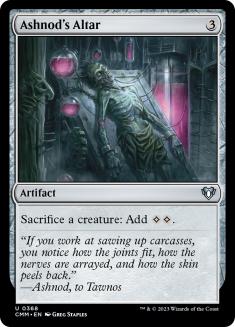
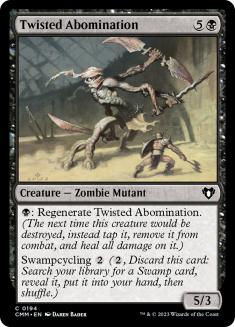
There is an argument for keeping in Commander’s Sphere given the introduction of Trading Post. It’s a decent argument, but in general I think Ashnod’s Altar is better in that slot. Ashnod’s Altar is a blast to play with, whether it’s helping your team avoid Final Judgment or just helping you ramp two mana at a time.
Meanwhile, Jet Medallion is uniquely weak in the Medallion cycle. In black decks with access to some of the mana doublers like Cabal Coffers, Magus of the Coffers, and Crypt Ghast, a basic Swamp is generally going to provide more of a discount as well as being more generally versatile. Twisted Abomination is an extra Swamp when you need it… it just has the added benefit of also being a regenerating Zombie with a body made to tangle. Living End in Modern does some truly amazing things with landcycling creatures into mass resurrection, but it works pretty well in Commander too.
Finishers
Out:
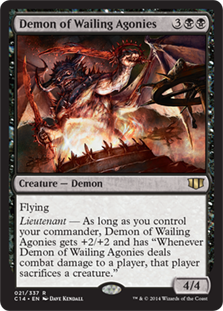
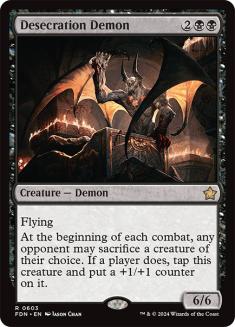
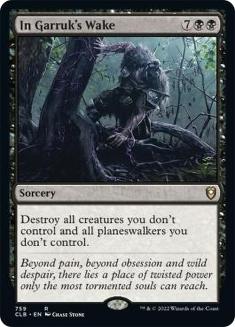
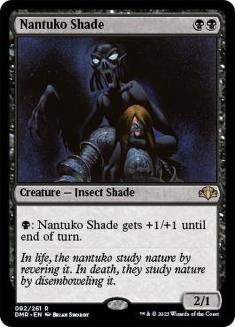
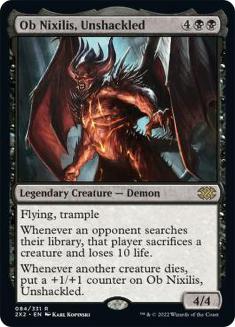
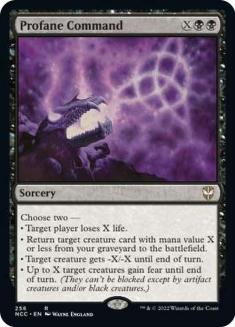
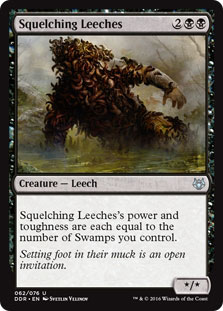
In:
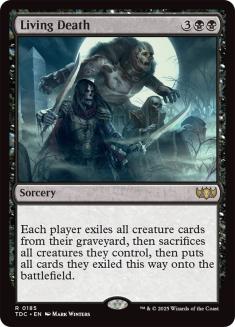
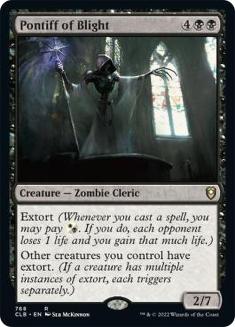
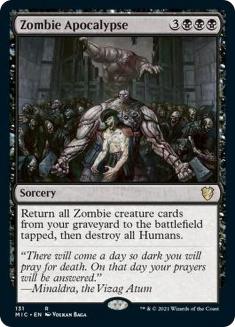
So let’s get back to my main point: you don’t need to play to win so much as you need to play around the loss. Baneslayer Angel cards, there to win the game, thus are often out of place in a deck that’s really playing for the grind. Demon of Wailing Agonies, Desecration Demon, Nantuko Shade, and Squelching Leeches can be blocked all day long in a format populated by chump blockers, and Desecration Demon in particular gives your opponents a free sacrifice outlet each combat. That’s a dangerous thing to offer, especially just in the service of cheap beef.
It’s even more instructive to compare these to Pontiff of Blight. While that card ostensibly is pointed at victory, it really helps you stay alive in the middle of a scrap by letting you channel extra mana into some bonus life when you otherwise run out of gas. It is itself a Zombie, meaning you can sacrifice it to Kalitas when you’d rather it be in the bin, and it makes each of the tokens Kalitas creates a little more powerful. All that, and on a body that isn’t particularly threatening and yet can have a major influence on the flow of attack. I’d take Pontiff of Blight over Demon of Wailing Agonies any day.
Ob Nixilis, Unshackled speaks to the disutility of hate cards in Commander. Hate cards, ones that shut down particular strategies, draw more aggro than you would think. If a player is playing on that particular axis, they are going to need to deal with the roadblock you have presented if they want to keep doing what they’re supposed to be doing. Sometimes they’ll have the removal spell, but surprisingly often the most efficient way of wiping out a hate card is to go through the player who owns it. Ob Nixilis, Unshackled irritates ramp decks to no end, sure, but also every deck that runs Evolving Wilds or Terramorphic Expanse. It draws a lot of attention, and the payoff, ten life and the loss of a creature, is more threatening than dangerous. An opponent can live through one or two of those taxes, only now they’re pissed. At you. Specifically.
Yikes.
Profane Command and In Garruk’s Wake are both interesting cuts. They end the game by giving you an Overrun of sorts, but In Garruk’s Wake is expensive and Profane Command’s X cost can be a drawback… although a monoblack deck is best positioned to rise to the challenge of both of these drawbacks with its mana engines. Regardless, they’re not on theme. Living Death, with Kalitas, Traitor of Ghet on the battlefield and Mogis’s Maurauder in the graveyard, is In Garruk’s Wake only better, forcing your opponents to sacrifice their team and then lose it to that commander’s exile effect. Kalitas really does it all: removing the symmetry of Living Death is powerful enough, but it lets you sacrifice Zombies and Vampires so that when you do play Living Death your creatures are coming back from premature sacrifice. Zombie Apocalypse does this too, but with less power, offset by more flavor.
Resurrection
Out:
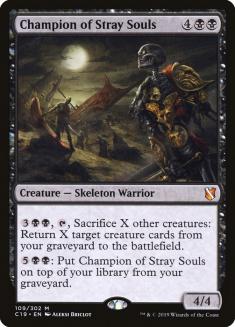
In:
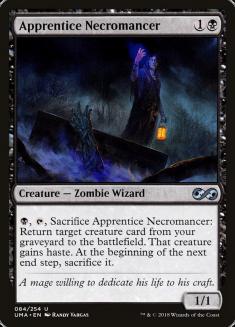
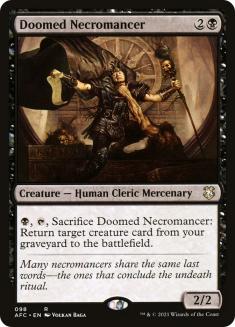
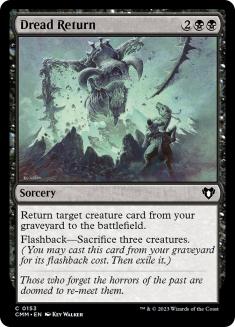
I’m cutting Champion of Stray Souls because it’s too slow and expensive. I’ve always wanted this card to work, but it’s just not quite there – the numbers always prove a little too unwieldy to provide the type of advantage you need when you need it. And yet, somehow I don’t find Apprentice Necromancer and Doomed Necromancer to have that same speed drawback despite them all having an activated ability that won’t be usable until you get through a turn cycle.
Part of that is just that they’re cheap; while they may not have the raw power of the Champion, landing on turn two or three can really help your game along. Part of it is also that it’s significantly easier to hold up one mana than it is to hold up five if you’re trying to maximize the value of a turn. And part of it is just that they threaten less harm, even if they could do more in the long run. Plus, Apprentice Necromancer has Zombie synergies and Doomed Necromancer triggers Xathrid Necromancer, providing you with synergies to go with your synergies. Champion of Stray Souls is just a Skeleton.
Dread Return is Dread Return. It’s a ton of fun when sacrificing things helps your plan, and it can be really helpful if you find the self-mill side of the deck. Definitely worth a spin.
Removal
Out:
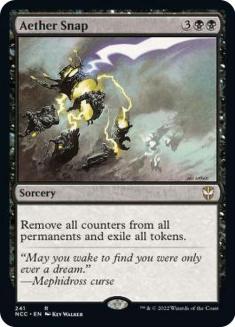
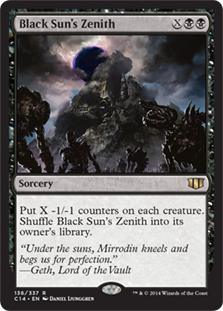
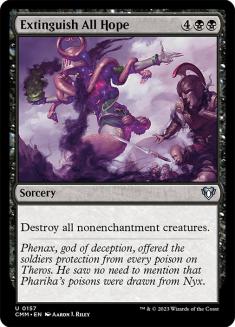
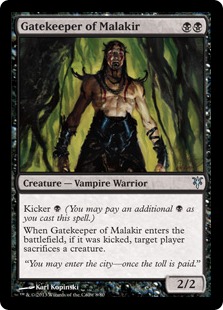
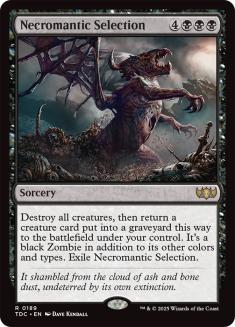
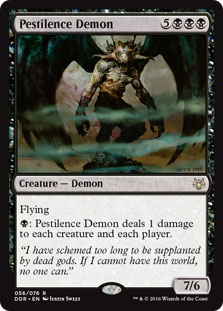
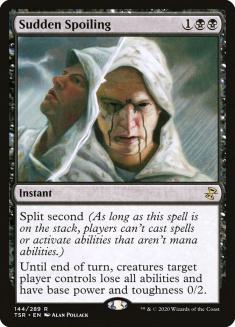
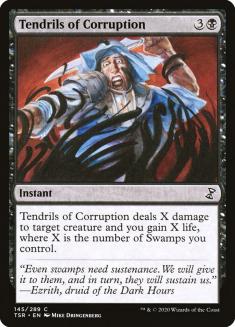
In:
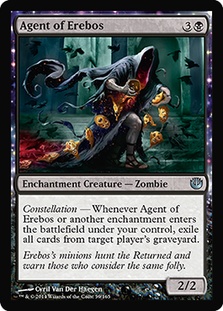
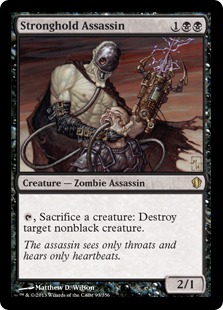
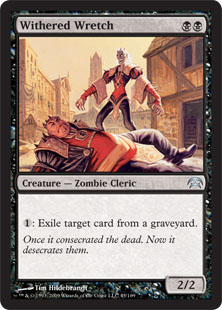
Kalitas, Traitor to Ghet keeps your opponents from getting death triggers (which, again, may cause some aggro), but there are still other ways to get creatures into the bin, and plenty of noncreature cards that can cause you some trouble from your opponents’ graveyards. Withered Wretch and Agent of Erebos are both Zombies that provide you with additional backup for Bojuka Bog and Kalitas. Agent of Erebos in particular is a great card because every once in a while you’ll get another trigger off a Greed or God.
Stronghold Assassin is a sacrifice outlet, removal, and a Zombie. This is exactly the type of deck it does well in. It’s not the fastest, but when you’re triggering Butcher of Malakir or Dictate of Erebos at the same time it can get pretty brutal pretty fast.
But, you know, in a fun way.
Aether Snap, Black Sun’s Zenith, Extinguish All Hope, and Pestilence Demon all offer mass removal that is likely going to wipe out your commander and your tokens at the same time. Since Living Death doubles as mass removal, we can cut some of these.
Gatekeeper of Malakir only gives you a benefit if you cast it, which means it’s dead weight when you cast Living Death. While you can return it to your hand with a couple of cards, in general this deck is more interested in going from the graveyard to the battlefield; the hand step represents the deck not working as smoothly as it should.
Sudden Spoiling and Tendrils of Corruption are both spells, which means they don’t have graveyard synergies. They’re just not powerful to make up for that drawback.
Finally, there’s Necromantic Selection. Necromantic Selection doesn’t work when Kalitas is on the battlefield. Necromantic Selection kills the creatures and then you get to choose from the creatures killed which one you want to return to the battlefield. Kalitas will exile all those creatures, though, leaving you with an overpriced Wrath of God that spares one of your creatures. It’s a shame; in the right context it’s a great spell! Kalitas just doesn’t want to be that deck.
Tutors
Out:
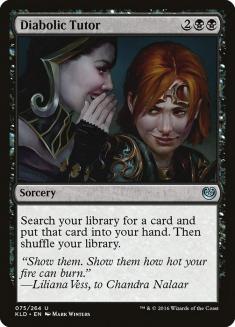
In:
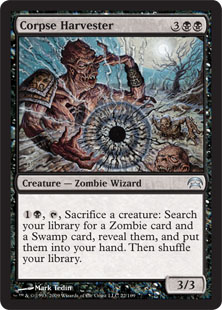
Blind tutors tend to scare people. If your opponent gets to search up the best card in his or her library and you don’t know what that card is, the wise play is to assume the worst. This can lead to a spike in the aggro you draw, as the people who are ahead of you suddenly need to prepare for a potential nuclear bomb even if you just used it to get a much-needed land. For something like Demonic Tutor, where the nostalgia level is huge, it’s probably worth it. When you have it tied to a Zombie with a sacrifice trigger, like Sidisi, Undead Vizier, it’s also worth the risk. But Diabolic Tutor isn’t quite powerful enough, given that as a spell it’s generally off-theme.
Instead, Corpse Harvester can be a fun way to capitalize on your Zombie synergies. It always gets you two cards, which is a plus. One of them is always going to be a Swamp, the other a Zombie, and you have to show what you grabbed, which should significantly ameliorate the aggro consequences of tutoring. It’s a sacrifice engine, which can be helpful given the resurrection themes. And it itself is a Zombie, meaning that it comes back during the Zombie Apocalypse. All in all, it’s fun and on-theme, and those are the most important factors.
Sacrifice
Out:
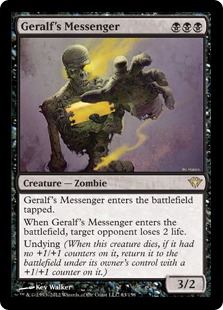
In:

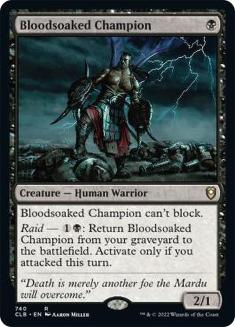
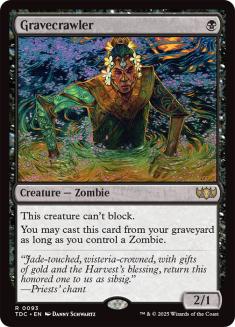
I’ve already mentioned the self-mill potential of Altar of Dementia; be assured that the “free sacrifice engine” aspect is as powerful on this card as it is on Ashnod’s Altar or Goblin Bombardment. Sometimes you just want your creatures to change state, and this lets you do that.
Of course, you need things to sacrifice. Creatures are the best, and nontoken ones have extra benefits like triggering Harvester of Souls and Grim Haruspex. Geralf’s Messenger is good, it gets you an extra death trigger and I have fond memories of it from Innistrad-block Standard, but the life tax isn’t all that aggressive in a 40-life format. Gravecaller and Bloodsoaked Champion are both significantly weaker cards than Geralf’s Messenger, but you can get three death triggers off the same mana cost with Gravecrawler and you don’t have to stop there. Bloodsoaked Champion is a little less powerful, and if it weren’t a pricey card these days I’d want Bloodghast in that slot, but it still offers a significantly more repeatable set of triggers and it does so at instant speed so long as you have triggered Raid.
Tokens
Out:
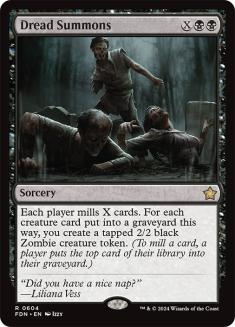
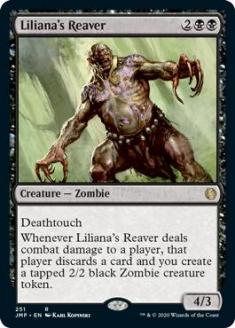
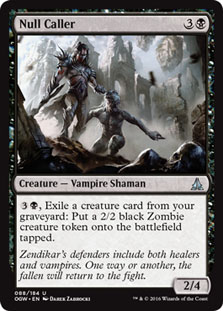
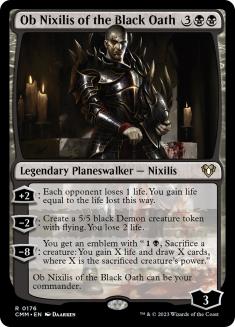
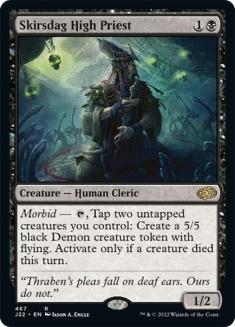
In:
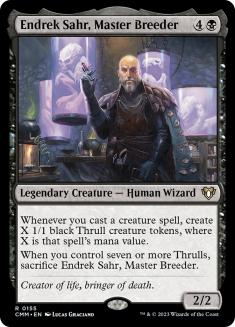
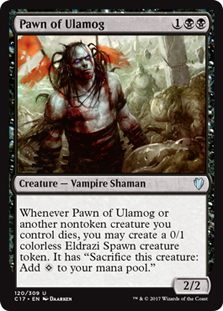
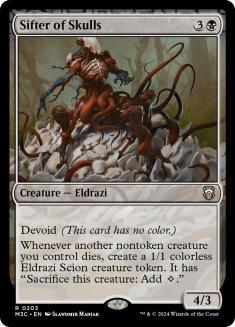
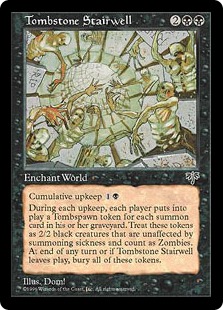
Of course, when you’re sacrificing stuff it’s good to have fodder for your Fodder Cannon. Tokens are generally useful for this, and it definitely helps that Kalitas, Traitor to Ghet comes with its own supply. Some of these other token generators don’t have the same power level, though, so they’re good candidates for cuts. Dread Summons is an X spell, which are generally mana inefficient, and has no means of being recurred once it gets milled. Altar of Dementia is much better here.
Liliana’s Reaver needs to connect to make tokens, and while the Deathtouch means it probably will, you’re looking at a fraction of a token per turn since every now and again you’re going to want to leave it back and you don’t have means in this deck of getting the benefit more than once a turn.
Ob Nixilis of the Black Oath gives a minor life swing and makes Demon tokens, neither of which is on-theme. Skirsdag High Priest also makes Demon tokens, and is slower and more vulnerable than the planeswalker. Both can be cut fairly readily.
Finally, there’s Null Caller. In decks like this I tend to be somewhat loathe to exile graveyard resources as part of a cost, but even if you’re on that plan there are better rates of return. Four mana is a lot, and even worse the tokens enter the battlefield tapped.
Endrek Sahr, Master Breeder also creates off-theme tokens, as do several of the other additions… but these are meaningfully different. Sahr creates a bunch of tokens at a time, and can really end up spawning a lot of bodies over its lifetime so long as you occasionally prune the Thrulls. With something like Ashnod’s Altar this can be an utter powerhouse, letting you gain mana on creature spells (albeit colorless mana). I actually run Endrek Sahr, Master Breeder as the commander for one of my decks, and I’d advise you to give it a shot sometime. It can be a lot of fun to switch up a commander in a deck to see what it’s like to always have access to different pieces, but if the machine is well-oiled it should work well no matter which legend in the deck is at the helm.
Pawn of Ulamog is a Vampire, which is a minorly-relevant tribal type if you’re trying to clear out the battlefield or pump Kalitas. Sifter of Skulls is an Eldrazi, so not sacrificable, but its base stats are combat-relevant and it can be nice to have a card that so effectively dodges the odd bit of color hate. They’re both additions because they make tokens whenever a nontoken creature you control dies, providing an effective force multiplier for your sacrifice shenanigans. But these tokens are better than the average token. Eldrazi Scions have relevant bodies while Eldrazi Spawn basically don’t, but they both produce mana and sacrifice on demand. When you have Butcher of Malakir or Dictate of Erebos in play, that’s incredibly relevant because you can be sure they’ll be going after your sacrifice enablers if they can’t take out the Grave Pact itself.
Finally, there’s Tombstone Stairwell. The relevant thing to know about Tombspawn is that they’re Zombie tokens. Since you have so many different ways to keep the creature count low in the other graveyards, it’s not a particularly symmetrical effect.
The List
Creatures (40)
- 1 Nekrataal
- 1 Withered Wretch
- 1 Doomed Necromancer
- 1 Graveborn Muse
- 1 Twisted Abomination
- 1 Corpse Harvester
- 1 Stronghold Assassin
- 1 Apprentice Necromancer
- 1 Endrek Sahr, Master Breeder
- 1 Magus of the Coffers
- 1 Shriekmaw
- 1 Cemetery Reaper
- 1 Vampire Hexmage
- 1 Butcher of Malakir
- 1 Pawn of Ulamog
- 1 Grave Titan
- 1 Reaper from the Abyss
- 1 Bloodgift Demon
- 1 Gravecrawler
- 1 Harvester of Souls
- 1 Crypt Ghast
- 1 Pontiff of Blight
- 1 Xathrid Necromancer
- 1 Abhorrent Overlord
- 1 Gray Merchant of Asphodel
- 1 Erebos, God of the Dead
- 1 Mogis's Marauder
- 1 Burnished Hart
- 1 Agent of Erebos
- 1 Soul of Innistrad
- 1 Bloodsoaked Champion
- 1 Grim Haruspex
- 1 Ghoulcaller Gisa
- 1 Flesh Carver
- 1 Overseer of the Damned
- 1 Archfiend of Depravity
- 1 Sidisi, Undead Vizier
- 1 Smothering Abomination
- 1 Corpse Augur
- 1 Sifter of Skulls
Planeswalkers (2)
Lands (38)
Spells (19)
- 1 Living Death
- 1 Sol Ring
- 1 Demonic Tutor
- 1 Greed
- 1 Ashnod's Altar
- 1 Victimize
- 1 Tombstone Stairwell
- 1 Mind Stone
- 1 Altar of Dementia
- 1 Worn Powerstone
- 1 Dread Return
- 1 Zombie Apocalypse
- 1 Trading Post
- 1 Underworld Connections
- 1 Codex Shredder
- 1 Whip of Erebos
- 1 Dictate of Erebos
- 1 Necromancer's Stockpile
- 1 Vampiric Rites

The Cost
While I didn’t have a stated budget, I generally try to keep these things reasonable, which largely entails eschewing expensive cards unless they’re really on theme. Here I managed to keep it all to $50.70, which isn’t all that bad given the $20 store credit to StarCityGames.com received by all those whose selections are chosen for inclusion in a column.
|
Card |
Cost |
|
0.15 |
|
|
0.25 |
|
|
0.35 |
|
|
0.35 |
|
|
0.39 |
|
|
0.49 |
|
|
0.49 |
|
|
0.49 |
|
|
0.49 |
|
|
0.49 |
|
|
0.49 |
|
|
0.49 |
|
|
0.49 |
|
|
0.49 |
|
|
0.49 |
|
|
0.49 |
|
|
0.49 |
|
|
0.65 |
|
|
0.75 |
|
|
0.79 |
|
|
0.79 |
|
|
0.99 |
|
|
Leechrideen Swamp |
1.29 |
|
1.39 |
|
|
1.79 |
|
|
1.79 |
|
|
1.99 |
|
|
1.99 |
|
|
2.45 |
|
|
3.99 |
|
|
6.99 |
|
|
15.69 |
|
|
Total |
50.70 |
If you’ve got some extra money to spend and find yourself disliking a theme here or there, I would advise picking up a Geth, Lord of the Vault. It makes a good commander if you want to try playing around with a new take on the monoblack archetype, and it’s a Zombie and thus nominally on theme. One of the things I love about monoblack is that the underlying mana engine can fit well into a lot of different styles of deck; Geth decks tend to be more rampy, but sometimes they win via mill, and that can be fun to play with.
Conclusion
Well, that’s it for this week! I hope you enjoyed this installment of Dear Azami; as always, please send us your submissions to DearAzami [at] gmail [dot] com. This could be you! And check out the Duel Decks: Blessed vs. Cursed. They’re a lot of fun for casual one-on-one play, and they tend to be pretty well balanced these days, if that means they’re underpowered compared to the norm. Still, if you ever are hankering for some low-stakes kitchen table Magic, the Duel Decks generally provide a chill way to scratch that itch.
This one has some cards from Shadows Over Innistrad in it, providing an interesting peek at what our return to the gothic horror plane has in store for us. I’m excited, are you?
Want to submit a deck for consideration to Dear Azami? We’re always accepting deck submissions to consider for use in a future article. Only one deck submission will be chosen per article, but being selected for the next edition of Dear Azami includes not just deck advice but also a $20 coupon to StarCityGames.com!
Email us a deck submission using this link here!
Like what you’ve seen? Feel free to explore more of Dear Azami here, in the Article Archives! And feel free to check Jess’s own Command of Etiquette column on Hipsters of the Coast for more Commander and casual content. Now on Thursdays!


